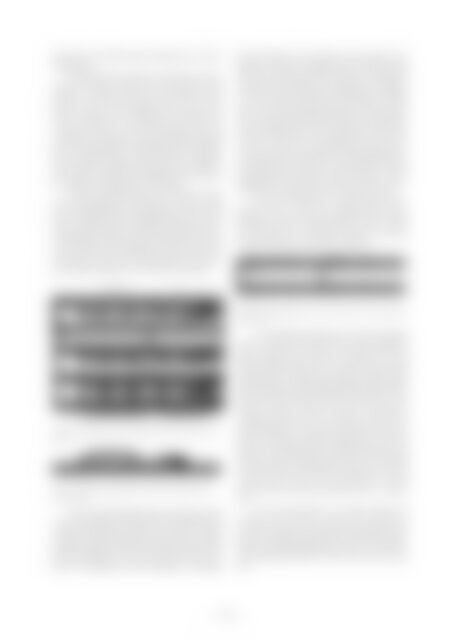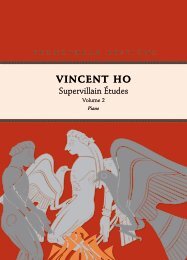You also want an ePaper? Increase the reach of your titles
YUMPU automatically turns print PDFs into web optimized ePapers that Google loves.
!<br />
#<br />
?<br />
?<br />
?<br />
!<br />
under the title Anthony Ritchie Symphonies <strong>No.1</strong> and 2<br />
(CD SLD-115).<br />
The title Boum comes from a novel by E.M. Forster,<br />
entitled A Passage to India, and is represented in the<br />
music by an ominous tam-tam stroke. This is the first<br />
sound we hear in the symphony. The ‘boum’ represents<br />
a mysterious echo experienced by characters in<br />
A Passage to India, on a visit to the Marabar Caves. The<br />
echo comes to symbolize the mysteries of life and death,<br />
and is a starting point to a general theme of existentialism<br />
and human struggle that pervades the symphony.<br />
The tam-tam stroke recurs throughout the symphony,<br />
also acting as a unifying device in the music.<br />
The first movement opens with sonorous strings,<br />
and modal ambiguity that becomes a feature of the<br />
work. A languid, Eastern-sounding theme in the violins<br />
(after rehearsal mark C) is influenced by gamelan music,<br />
referencing the pelog scale. This theme also recurs in<br />
each movement of the symphony (see L1 in the second<br />
movement, the più mosso before T1 in the third movement,<br />
and the change to Fh in the fourth movement).<br />
°<br />
poco accel.<br />
ppp mp ppp<br />
div.<br />
unis.<br />
ppp mp ppp<br />
non div.<br />
ppp mp ppp<br />
# - - - - - - - - > - - - - - - ?<br />
Œ œ œ œ œ œ œ œ œ œ œ œ œ œ œ ˙.<br />
¢<br />
ppp mp ppp<br />
rit.<br />
! ∑ ∑ ?<br />
B<br />
Œ<br />
Yœ- œ- œ- œ- œ- œ- œ- œ- œ ><br />
- œ- œ- œ- œ- œ<br />
-<br />
˙.<br />
Œ Yœ œ œ œ œ œ œ œ<br />
œ- - - - - - - œ<br />
- ><br />
- œ- œ- œ- œ- œ<br />
-<br />
˙.<br />
Œ<br />
œ<br />
- œ - œ - œ - œ - œ - œ - œ œ œ œ œ œ œ<br />
- ><br />
- - - - - - ˙˙..<br />
(Figure 1. String figure from the opening of Boum’s first movement, measures<br />
2–3)<br />
! Œ<br />
œ<br />
p<br />
Yœ<br />
œ Yœ<br />
œ Yœ<br />
œ A<br />
(Figure 2. Eastern-sounding violin theme from Boum’s first movement,<br />
measures 43–45)<br />
After a gradual build-up the first main theme of the<br />
sonata form appears in the brass at E, a theme that has<br />
a muscular, Brucknerian quality. This leads to a sinuous<br />
saxophone melody, related to the Eastern theme, which<br />
becomes significant in the central section of the movement.<br />
The saxophone in this symphony is associated<br />
with the human voice, plaintive and emotional. Also<br />
plaintive in sound is the lengthy oboe solo starting at M,<br />
the second main theme of the movement. Development<br />
of themes and motifs follows, culminating in a build-up<br />
over a D pedal note that betrays the influence of Philip<br />
Glass. The Cd meter gradually morphs into Fh at the climax<br />
and a crashing tam-tam stroke heralds the recapitulation<br />
of the opening chords. The recapitulation in fact turns<br />
out to be a coda, as the developmental energy of previous<br />
themes has been exhausted. The string passage from<br />
the opening returns with more emotional power, before<br />
evaporating into harmonics at the end (akin to spirits<br />
floating away), punctuated by a final tam-tam stroke.<br />
The second movement is a vigorous scherzo, outlining<br />
an A–B–A–C–A form. It is dominated by two basic<br />
elements: the sharp opening rhythm of three crotchet<br />
beats followed by a syncopated motif (m.3), and the<br />
sound of log drum and tom-toms combined.<br />
°<br />
! W Wœ œ œ Œ<br />
. . . W œ œ ‰ œ j Ó<br />
. . .<br />
mf<br />
a2<br />
œ. œ. œ. . . .<br />
¢<br />
Œ œ œ ‰ œ J Ó<br />
mf<br />
(Figure 3. Opening rhythm from the second movement, oboes and clarinets,<br />
measures 2-3)<br />
I was inspired by performances of a local Dunedin<br />
group, Te Orana, which played Cook Island traditional<br />
music. Melodic lines repeat and expand from these<br />
simple rhythmic elements. The second section (starting<br />
at E1) features a string quartet playing a simple modal<br />
theme, built from the opening rhythmic elements which,<br />
along with the persistent log drum, helps create a link<br />
between sections A and B. In section C, the Easternsounding<br />
theme from the first movement returns, and<br />
here it is linked by a common rising motif: two notes up<br />
and down, forming an ostinato through this section. The<br />
theme is used canonically at the climax, before hurtling<br />
into the boisterous recapitulation of section A. The three<br />
crotchet beats from the start are elongated into a long<br />
stream of notes, and the movement roars to a conclusion.<br />
The third movement was written during the<br />
Bosnian war in 1993 and is a lament for its victims. The<br />
evocative opening was inspired by the wailing of a Māori<br />
karanga, with descending phrases and use of glissandi,<br />
while tolling bells imbue the music with a sense of tragedy.<br />
UME14 – v


















